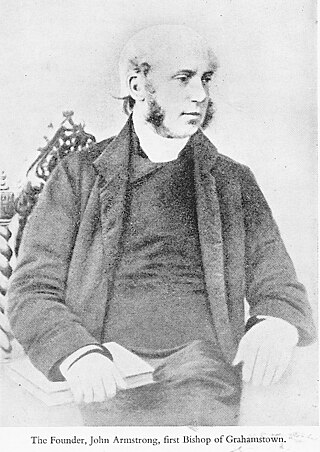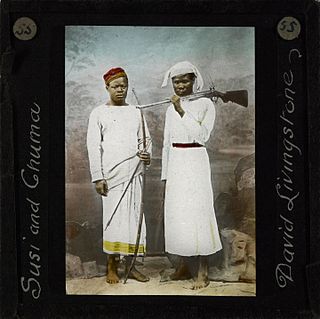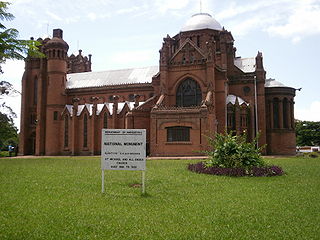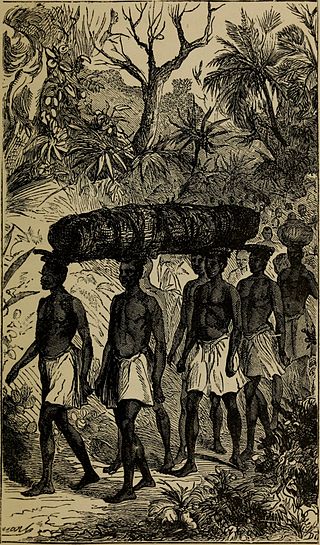
Edward Steere (1828 - 26 August 1882) was an English Anglican colonial bishop in the 19th century. [1]

Edward Steere (1828 - 26 August 1882) was an English Anglican colonial bishop in the 19th century. [1]
Steere was educated at London University and ordained in 1850. [2] After curacies in Devon and Lincolnshire, he joined William Tozer (Bishop in Central Africa) on a mission to Nyasaland in 1863. [3] He was appointed Bishop in Central Africa [4] in 1874 and died on 26 August 1882. [5]
Steere spent several periods in Zanzibar, 1864-68, 1872-74, and 1877-82. In 1873 he placed the foundation stone at Christ Church, Zanzibar, in Stone Town, Zanzibar. The cathedral was based on his vision; its concrete roof shaped in a barrel vault was Steere's idea. He also worked with David Livingstone to abolish slavery in Zanzibar. He is buried behind the altar in the church. [6] David Livingstone's aides James Chuma and Abdullah Susi were part of an expedition led by Steere. Chuma was captain of the expedition and both men acted as interpreters. [7]
Steere was a considerable linguist and published works on several East African languages and dialects, including Shambala, Yao, Nyamwezi, and Makonde. But he is especially known for his work on Swahili, publishing a Handbook of Swahili in 1870, and he also translated or revised the translation into Swahili of a large part of the Bible. [8]

Johann Ludwig Krapf was a German missionary in East Africa, as well as an explorer, linguist, and traveler. Krapf played an important role in exploring East Africa with Johannes Rebmann. They were the first Europeans to see Mount Kenya with the help of Akamba who dwelled at its slopes and Kilimanjaro. Ludwig Krapf visited Ukambani, the homeland of the Kamba people, in 1849 and again in 1850. He successfully translated the new testament to the Kamba language. Krapf also played a key role in exploring the East African coastline, especially in Mombasa.

John Armstrong was a Church of England cleric who became the Bishop of Grahamstown in South Africa.
Swahili literature is literature written in the Swahili language, particularly by Swahili people of the East African coast and the neighboring islands. It may also refer to literature written by people who write in the Swahili language. It is an offshoot of the Bantu culture.
{{Infobox diocese | bishopric = Grahamstown | border = anglican | incumbent = [[no bishop at the moment | province = Southern Africa | cathedral = St. Michael and St. George Cathedral | diocese = Grahamstown }}

James Chuma and Abdullah Susi were people from central Africa who took part in the second Zambesi expedition led by the explorer David Livingstone, and were employed by him in his last expedition. They had significant roles in organisation, and were the first to greet Stanley when his search party made contact.

Frank Weston (1871–1924) was the Anglican Bishop of Zanzibar from 1907 until his death 16 years later.

The Universities' Mission to Central Africa was a missionary society established by members of the Anglican Church within the universities of Oxford, Cambridge, Durham, and Dublin. It was firmly in the Anglo-Catholic tradition of the Church, and the first to devolve authority to a bishop in the field rather than to a home committee. Founded in response to a plea by David Livingstone, the society established the mission stations that grew to be the bishoprics of Zanzibar and Nyasaland, and pioneered the training of black African priests.

Chauncy Maples was a British clergyman and Anglican missionary who became Bishop of Likoma, with a diocese in East Africa.
Robert Selby Taylor was an Anglican bishop in the 20th century.

Henry Cotterill was an Anglican bishop serving in South Africa in the second half of the 19th century. From 1872 until death he was a bishop of the Scottish Episcopal Church in Edinburgh.
William Edmund Smyth (1858–1950) was an Anglican bishop in the last decade of the nineteenth century and the first two of the twentieth.
‘Abd al-‘Azīz al-Amawī (Arabic: عبد العزيز الأموي; 1838–1896) was a Somali scholar following the Shāfi‘ī school of jurisprudence and the Ash'arite school of theology, and was a Sufi shaykh of the Qādiryya Sufi order, of which he established his own branch. He was also adviser to several sultans of Zanzibar.

Christ Church is an Anglican cathedral in Stone Town, Zanzibar, Tanzania. It belongs to the Anglican Church of Tanzania. It is a landmark historical church, as well as one of the most prominent examples of early Christian architecture in East Africa.

According to the 2018 census, 77.3% of the population is Christian. Denominations include Roman Catholics at 17.2% of the total population, Central Africa Presbyterians at 14.2%, Seventh-day Adventist at 9.4%, Anglicans at 2.3%, Pentecostals at 7.6% and other denominations at 26.6%.
Annie Allen was a Christian medical missionary from England. She worked in Zanzibar in the 1870s and 1880s.
John Prediger Farler (1845-1907) was an Anglican priest, most notably Archdeacon of Magila from 1879 until 1889.
Francis Roger Hodgson was a British Anglican missionary and Bible translator in Zanzibar, and later a parish priest in Devon, England.

Jacob Wainwright was a Black African man who worked as an attendant for the explorer David Livingstone.
Arthur Cornwallis Madan (1846–1917) was a British linguist and Anglican missionary who became famous for his research on African languages and his Swahili dictionaries.

Cecil Majaliwa was a former slave from Zanzibar who became the first African to be ordained as a priest in what is now Tanzania. After being freed, he was educated in Zanzibar and England by the Universities' Mission to Central Africa. He was highly successful during eleven years as an Anglican missionary in the south of the country. However, the European leaders of the mission downplayed his achievements and failed to promote him.